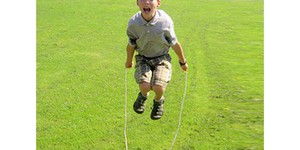Sports Science Science Projects (57 results)
Top athletes and coaches use a whole lot of science and engineering to improve performance and increase the chances of winning. Technologies like better tennis rackets, sleeker running and swimming outfits, and aerodynamic soccer balls, mean that current athletes are breaking world records left and right. Add to that better nutrition and science-based training regimes and you have an era of amazing athletes! Explore how science and engineering impact your favorite sport.
|
Select a resource
Sort by
|
Aerodynamics and Hockey: Does the Force of Drag Have an Effect on the Distance the Puck Will Travel?
Think of a way to launch the puck with a reproducible force, and examine the effect of launching the puck in different orientations on the distance it travels. For more information on the physics, see Haché, 2002.
Read more
Featured
Have you heard that garlic powder is supposed to inhibit the growth of bacteria? Which do you think would make a better disinfectant: a solution of garlic powder or a solution of bleach? This project shows you a straightforward way to compare the effectiveness of different disinfectants (or other antimicrobial agents), by measuring zones of inhibition on a culture plate.
Read more
When the punter is trying to hit the "coffin corner" (within the opposing team's 10-yard line), out of bounds, what is the best angle to kick the ball for correct distance and maximum "hang time?" (For more information on the physics involved, see: Gay, 2004, Chapters 4 and 5.)
Read more
The rebound rating is the ratio of the height the ball bounces to, divided by the height the ball was dropped from. Use the rebound rating to measure the bounciness of new tennis balls vs. balls that have been used for 10, 20, 50, and 100 games. Another idea to explore: does it matter what type of court the ball is used on? (See: Goodstein, 1999, 63-64.)
Read more
Think of hitting a baseball, heading a soccer ball into the net, or hitting a tennis ball with a racquet. Where the ball goes depends on...what? You can set up a simple model to start your investigation. You'll need a marble, a flat piece of wood, a flat piece of cardboard, a pencil, a ruler, a protractor, and a level surface. Lay down the cardboard down on a level surface and set up the flat piece of wood at one edge. The wood will act like a wall, and you're going to roll the marble at…
Read more
Have you ever seen a skateboarder jump over an obstacle or slide down a railing? It looks like they are defying the laws of physics when they perform these tricks. It looks like it, but that's not the case. Physics describes the motion of objects and it is a skateboarder's best friend! All of these tricks can be explained by physics. In this sports science fair project, you will learn how speed affects "popping an ollie." The ollie is a basic skateboarding trick, and it's the first step to more…
Read more
Watching professional racing-car drivers compete can be thrilling. The high speeds that racing cars can reach — up to 200 miles per hour (mph) and more! — put some unique demands on the vehicles. For example, to withstand high temperatures, the tires must be inflated with nitrogen gas, instead of air as with normal car tires. This enables the drivers to have better control over steering their cars as they race around the track. In this sports science project, you will inflate…
Read more
You can model this with an ice cube sliding down a plank: how high do you need to lift the end of the plank before the ice cube starts to slide? Try this with one side plain wood and the flip side waxed wood (use paraffin wax, candle wax or ski wax). Make sure both sides are equally smooth to start with. Do at least three trials. More advanced: using what you know about the forces acting on the ice cube, derive equations to calculate the coefficient of friction for each case. Variation:…
Read more
Did you know that the world record for the greatest number of jumps in a minute is more than 340? That's more than five jumps a second! How close do you think you can get to that number? If you are going to try to break the record, it might be important to figure out how jump rope length affects your success. Try your hand at this skipping science fair project and jump-start your chances for a jump rope record. If you have a smartphone available, you can use its accelerometer and a sensor app…
Read more
The goal of every golfer is to hit the golf ball as far as possible down the fairway. A key factor in determining the distance that the ball will travel is the velocity of the club when it strikes the ball. In this sports science fair project, you will determine exactly how distance is related to club velocity. Time to tee off!
Read more
This project can apply to soccer, hockey, baseball and many other sports. What is the effect of stopping the kick/shot/swing at the moment of impact vs. following through? Think of a way to measure the outcome in each case, and explain your results. (idea from Gardner, 2000, 83-85; for more information with regard to specific sports, see: Barr, 1990, 12-14; Gay, 2004, 142-144; Adair, 2002, 30.)
Read more
|
Explore Our Science Videos
Make Fake Snow - Craft Your Science Project
Slippery Slopes - STEM activity
How Antibiotic Resistant Bacteria Take Over – STEM activity









